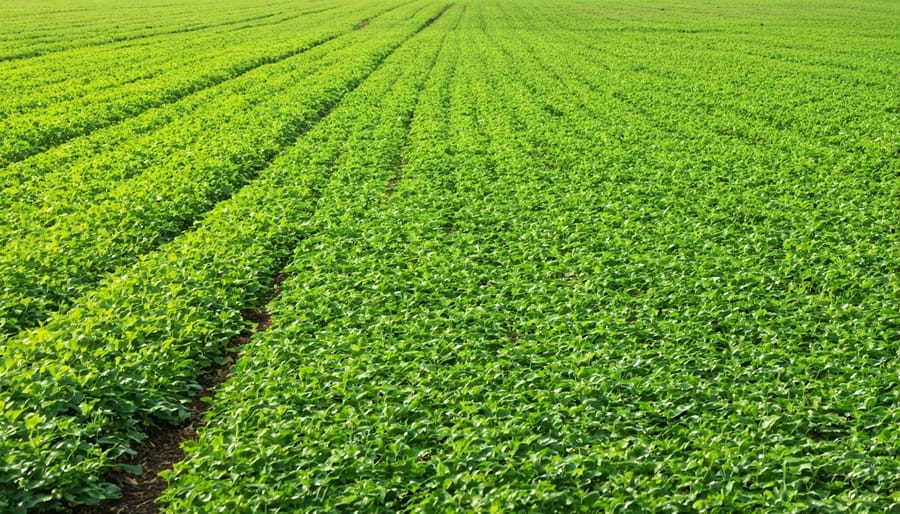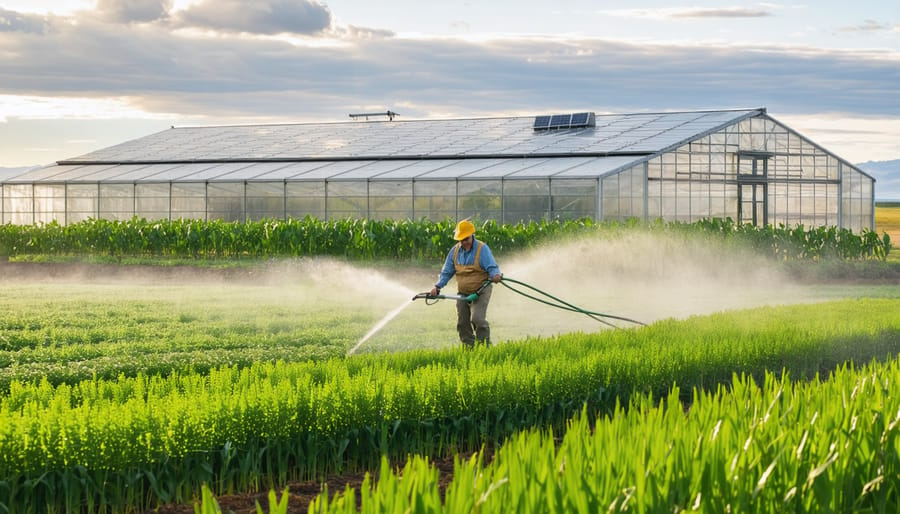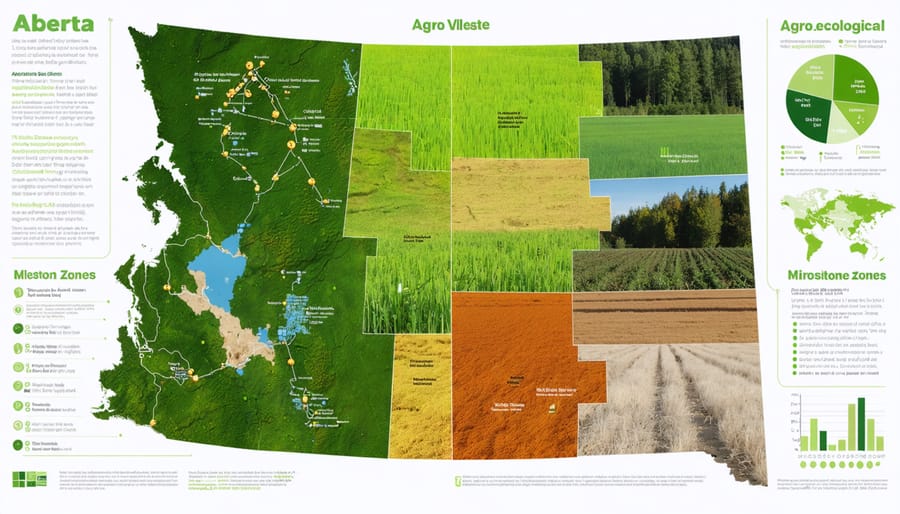Cover Cropping: Nourish Your Soil, Protect the Planet
Cover cropping is a powerful climate-smart practice that can significantly improve soil health, reduce erosion, and sequester carbon in Alberta’s agricultural lands. By planting crops like legumes, grasses, or brassicas between main crop cycles, farmers can protect and nourish their soil while contributing to a more sustainable future.
Leguminous cover crops, such as clover, alfalfa, or field peas, fix atmospheric nitrogen in the soil, reducing the need for synthetic fertilizers. This not only saves farmers money but also minimizes greenhouse gas emissions associated with fertilizer production and application. Grassy cover crops, like ryegrass or barley, develop extensive root systems that hold soil in place, preventing wind and water erosion. Their biomass also adds organic matter to the soil, improving its structure, water retention, and nutrient cycling.
When cover crops are terminated and incorporated into the soil, they sequester carbon, effectively removing it from the atmosphere and storing it in the ground. This process, known as carbon sequestration, is a critical tool in mitigating climate change. According to a study by the University of Alberta, cover cropping can sequester up to 1.2 tons of carbon per hectare per year in Alberta’s soils.
To maximize the benefits of cover cropping, Alberta farmers should consider factors like their main crop rotation, soil type, and climate when selecting cover crop species. Planting a diverse mix of cover crops can provide multiple benefits and enhance soil biodiversity. Farmers can also experiment with different termination methods, such as crimping, mowing, or grazing, to find the most suitable approach for their operation.
By adopting cover cropping as part of a comprehensive climate-smart strategy, Alberta farmers can build healthier, more resilient soils while contributing to global efforts to combat climate change. With the right knowledge and support, cover cropping can become a standard practice in Alberta’s agricultural landscape, ensuring a more sustainable future for generations to come.

Smarter Nitrogen Management for a Greener Farm
Smarter nitrogen management is a key strategy for reducing emissions and optimizing crop yields on your farm. By using precision application techniques and strategic timing, you can minimize waste and environmental impact while supporting healthy plant growth.
Consider practices like split application, where nitrogen is applied in multiple smaller doses throughout the growing season based on crop needs. This allows plants to utilize nutrients more efficiently and reduces the risk of excess nitrogen leaching into groundwater or being released as nitrous oxide, a potent greenhouse gas.
Tools like soil testing, crop sensors, and variable rate technology can help you determine the optimal nitrogen rate for each part of your field, accounting for spatial variability. For example, Alberta farmers have seen success using GreenSeeker sensors to assess plant health and make real-time fertilizer adjustments.
Timing is also critical – aim to sync applications with peak crop demand and avoid applying before heavy rains that can cause runoff. Incorporating nitrogen-rich cover crops and reducing tillage can further improve soil health and retention.
By adopting these smarter nitrogen management practices tailored to your farm’s unique conditions, you can work towards a more productive and sustainable operation. Reach out to local agricultural organizations and experts for support as you implement these climate-smart techniques in your fields.

Embrace No-Till: Boost Yields While Battling Climate Change
No-till farming is a game-changer for Canadian farmers looking to boost yields while fighting climate change. By minimizing soil disturbance, no-till practices enhance soil structure, allowing for better water retention and nutrient cycling. This leads to healthier, more resilient crops that can withstand the challenges of a changing climate.
But the benefits don’t stop there. No-till farming also helps sequester carbon in the soil, reducing greenhouse gas emissions and contributing to a more stable climate. In fact, studies have shown that no-till fields can store up to 30% more carbon than conventionally tilled fields.
Of course, making the switch to no-till can be daunting. Many farmers worry about weed control, equipment costs, and the learning curve involved. But with the right strategies and support, these challenges can be overcome. Experts recommend starting small, seeking advice from experienced no-till farmers, and being patient as your soil adapts.
The rewards are well worth the effort. Alberta farmers who have embraced no-till report better soil health, higher yields, and lower input costs. As one farmer put it, “No-till has transformed my farm. I’m producing more with less, and I feel good knowing I’m doing my part for the environment.”
So if you’re ready to take your farm to the next level, consider giving no-till a try. With its powerful combination of economic and environmental benefits, it just might be the key to a more sustainable, profitable future for Canadian agriculture.

Resilient Rotations: Diversity for Sustainability
Resilient crop rotations are a cornerstone of sustainable agriculture, particularly in the challenging growing conditions of Alberta. By strategically alternating crops each season, farmers can enhance soil fertility, disrupt pest and disease cycles, and reduce reliance on synthetic inputs. Diverse crop rotations that include legumes, such as peas and lentils, fix atmospheric nitrogen in the soil, reducing the need for chemical fertilizers. Incorporating cover crops, like clover or rye, can prevent erosion, suppress weeds, and add organic matter to the soil.
For Alberta’s short growing season, a four-year rotation plan might include canola, spring wheat, field peas, and barley. This sequence balances nutrient demands, breaks disease cycles, and provides diverse income streams. Adapting the rotation to local soil types and microclimates is key. Consulting with experienced agronomists and tapping into the wisdom of neighboring farmers can help refine your rotation strategy.
While transitioning to diverse rotations may require initial investments in new equipment or infrastructure, the long-term benefits are clear. By fostering a resilient, self-sustaining ecosystem, farmers can buffer against the impacts of climate change, reduce input costs, and ensure the viability of their land for generations to come. Embracing the power of crop diversity is an essential step towards a climate-smart future for Alberta agriculture.
Graze the Sustainable Way: Managed Grazing of Livestock
Managed grazing, a climate-smart practice championed by the USDA, offers a multitude of benefits for Canadian farmers, particularly those in the Alberta region. By strategically moving livestock through pastures, farmers can improve soil health, reduce greenhouse gas emissions, and enhance their financial stability. Managed grazing involves dividing pastures into smaller sections and rotating animals through them based on forage growth and recovery. This practice mimics natural grazing patterns, allowing for more even nutrient distribution and reduced soil compaction.
To implement managed grazing effectively, farmers should assess their pastures’ carrying capacity and adjust stocking rates accordingly. Monitoring forage height and quality is crucial to determine when to move animals to a new section. Providing adequate rest periods for each pasture section allows for optimal plant regrowth and root development, which in turn supports soil health and carbon sequestration.
Real-farm examples across Alberta demonstrate the positive impacts of managed grazing. For instance, a cattle ranch near Edmonton reported a 15% increase in forage production and a 20% reduction in feed costs after implementing a rotational grazing system. Another farm in the Peace River region noted improved soil organic matter and water retention, leading to more resilient pastures during drought conditions.
By adopting managed grazing practices, Canadian farmers can contribute to national climate goals while ensuring the long-term sustainability and profitability of their operations. With proper planning and execution, managed grazing offers a win-win solution for both the environment and the agricultural community.
Conclusion
The adoption of USDA climate-smart practices presents a significant opportunity for Alberta farmers to lead the way in sustainable agriculture. By implementing these strategies, such as cover cropping, reduced tillage, and precision nutrient management, farmers can enhance soil health, reduce greenhouse gas emissions, and build resilience against climate change impacts. The benefits extend beyond environmental stewardship, as these practices can also improve crop yields, reduce input costs, and contribute to the long-term viability of agricultural operations. As stewards of the land, Alberta farmers have the power to make a profound impact on the future of agriculture and the well-being of our planet. By embracing these climate-smart solutions, we can work together to create a more sustainable and prosperous agricultural community for generations to come.











